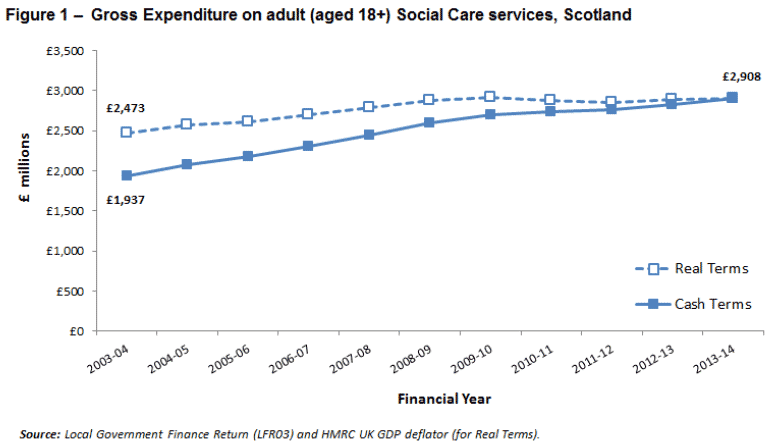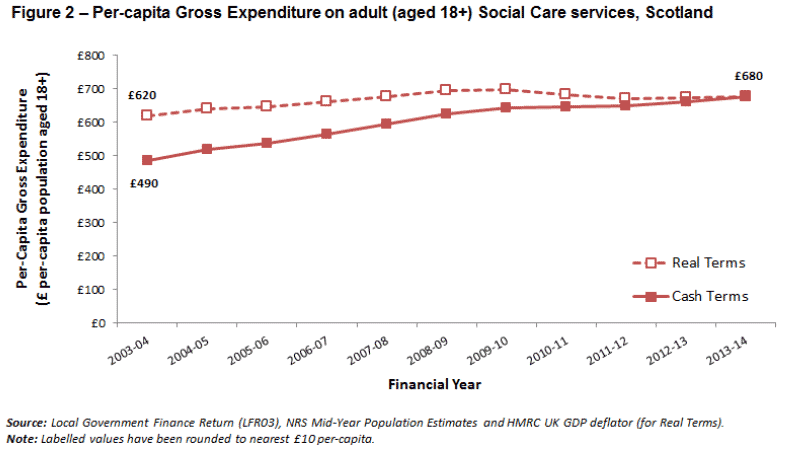Expenditure on Adult Social Care Services, Scotland, 2003-04 to 2013-14
Presents detailed analysis of expenditure on adult Social Care services in Scotland over the financial years 2003-04 to 2013-14.
2. Trends in Gross Expenditure, Scotland, 2003-04 to 2013-14
Gross Expenditure by local authorities on adult (aged 18+) Social Care services in Scotland in 2013/14 was £2,908 million[1]. This figure represents 74% of the £3,923 million of Gross Expenditure on Total Social Work (the totality of the client groups covered by the LFR03, see Section 9.2.4), with the remainder being divided between £865 million (22%) on Children and Families services and £151 million (4%) on the Support Strategy, the Children's Panel and Criminal Justice Social Work.
Figure 1 shows that a cash terms increase in Gross Expenditure on adult (aged 18+) Social Care services occurred every year from 2004-05 to 2013-14[2]. Gross Expenditure in 2013-14 represents a 50% increase in cash terms on 2003-04. Changes in expenditure may also be expressed in 'real terms', by stripping out the effects of general inflation within the UK economy (see Section 9.3.4). Figure 1 shows that real terms increases in Gross Expenditure occurred each year from 2004-05 to 2009-10, followed by decreases in 2010-11 and 2011-12 and further increases in 2012-13 and 2013-14. Gross Expenditure in 2013-14 represents an 18% increase in real terms on 2003-04.

Expenditure may also be expressed per-capita of the relevant population, such that comparisons through time reflect any concurrent changes in demography (see Section 9.3.5). Gross Expenditure on adult (aged 18+) Social Care services in Scotland in 2013-14 equates to £680 per-capita of the population aged 18+. Figure 2 shows that increases in real terms per-capita expenditure occurred each year from 2004-05 to 2009-10, followed by decreases in 2010-11 and 2011-12 and further increases in 2012-13 and 2013-14. Gross Expenditure in 2013-14 represents a 9% increase in real terms per-capita on 2003-04. Comparison of this value with the 50% cash terms increase indicates that the majority, but not the entirety, of the latter is attributable to the combined effects of inflation and growth in the adult population.

Trend analysis of Gross Expenditure may be produced at the level of client group and local authority using Chart 1A of the data spreadsheet. As is summarized in Table 1, per-capita expenditure on older people (aged 65+) is much greater (£1,840 per-capita of the population aged 65+ in 2013-14) than that on younger adults (aged 18-64) (£350 per-capita of the population aged 18-64 in 2013-14). Per-capita expenditure on services for younger adults (aged 18-64) has increased by 16% in real terms over the period 2003-04 to 2013-14. In contrast, per-capita expenditure on services for older people (aged 65+) has decreased by 1% in real terms over the same period. For the older people (aged 65+) client group, the entirety of the cash terms expenditure increase (46%) is seen to be attributable to the combined effects of inflation and rapid growth in this section of the population.
Table 1 - Summary of trends in Gross Expenditure by adult client age group
| Change in Gross Expenditure |
Older People |
Adults |
|---|---|---|
| Cash terms |
46% increase |
56% increase |
| Real terms |
15% increase |
22% increase |
| Real terms per-capita |
1% decrease |
16% increase |
Comparisons of per-capita trends in Gross Expenditure between two regions may be produced using Chart 2A, and between the main client age groups using Chart 3A.
Trend analysis of Gross Expenditure on a specific service-type (e.g. Care Homes, or Home Care), rather than across all services, may be produced using Charts 1B, 2B and 3B of the data spreadsheet. Service-type expenditure data is not comparable between 2011-12 and 2012-13, due to a change in LFR03 recording practice (see Section 9.3.2).
Contact
Email: Steven Gillespie
There is a problem
Thanks for your feedback